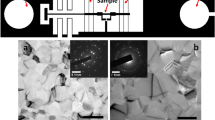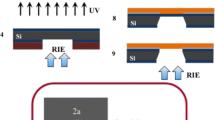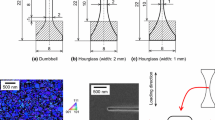Abstract
Freestanding nanocrystalline Au films, subjected to nominally elastic loads at 25–110 °C, demonstrated high primary (10−7–10−4 s−1) and steady-state creep rates (10−8–10−5 s−1). The deformation mechanisms for creep were strongly temperature dependent: grain boundary sliding-based creep dominated at room temperature and 50 °C, while the contribution of dislocation-mediated creep increased at 80 and 110 °C. The effect of applied stress on primary and steady-state creep strain at different temperatures was captured well by a non-linear model that was based on the kinetics of thermal activation. Multi-cycle creep experiments showed that at room temperature virtually all the primary strain accumulated during each forward creep cycle was recovered upon complete unloading. As the contribution of dislocation-mediated creep increased with temperature, the ratio of strain recovery to primary strain accumulated during each cycle was reduced due to the accumulation of plastic strain at higher temperatures. Notably, at all temperatures, the steady-state creep rate decreased after the first creep cycle. Moreover, the entire creep response remained virtually unchanged in all subsequent cycles, which implies that the first creep cycle resulted in mechanical annealing. This conclusion was further supported by calculations of the activation entropy: A reduction in its magnitude between the first and all subsequent creep cycles at all temperatures pointed out to mechanical annealing of initial material defects during the first loading cycle. The negative values of the calculated activation entropy indicated that entropy changes due to annihilation of defects-dominated entropy changes associated with the generation of new defects. Finally, the activation entropy for steady-state creep was temperature insensitive, but increased with stress, which is consistent with an increase in defect generation at higher stresses.












Similar content being viewed by others
References
Hsu H, Peroulis D (2010) A viscoelastic-aware experimentally-derived model for analog RF MEMS varactors. In: 2010 IEEE 23rd international conference micro electro mechanical systems, pp 783–786
Jonnalagadda KN, Chasiotis I, Yagnamurthy S et al (2010) Experimental investigation of strain rate dependence of nanocrystalline Pt films. Exp Mech 50:25–35
Meyers M, Mishra A, Benson D (2006) Mechanical properties of nanocrystalline materials. Prog Mater Sci 51:427–556
Kumar K, Van Swygenhoven H, Suresh S (2003) Mechanical behavior of nanocrystalline metals and alloys. Acta Mater 51:5743–5774
Chasiotis I, Bateson C, Timpano K et al (2007) Strain rate effects on the mechanical behavior of nanocrystalline Au films. Thin Solid Films 515:3183–3189
Wei Q, Cheng S, Ramesh K, Ma E (2004) Effect of nanocrystalline and ultrafine grain sizes on the strain rate sensitivity and activation volume: fcc versus bcc metals. Mater Sci Eng A 381:71–79
Emery R (2003) Tensile behavior of free-standing gold films. Part II. Fine-grained films. Acta Mater 51:2079–2087
Wang L, Prorok BCCB (2008) Characterization of the strain rate dependent behavior of nanocrystalline gold films. J Mater Res 23:55–65
Jonnalagadda K, Karanjgaokar N, Chasiotis I et al (2010) Strain rate sensitivity of nanocrystalline Au films at room temperature. Acta Mater 58:4674–4684
Wei Y, Bower AF, Gao H (2008) Enhanced strain-rate sensitivity in fcc nanocrystals due to grain-boundary diffusion and sliding. Acta Mater 56:1741–1752
Padilla HA, Boyce BL (2010) A review of fatigue behavior in nanocrystalline metals. Exp Mech 50:5–23
Yamakov V, Wolf D, Salazar M et al (2001) Length-scale effects in the nucleation of extended dislocations in nanocrystalline Al by molecular-dynamics simulation. Acta Mater 49:2713–2722
Li JCM (1960) The interaction of parallel edge dislocations with a simple tilt dislocation wall. Acta Metall 8:296–311
Coble RL (1963) A model for boundary diffusion controlled creep in polycrystalline materials. J Appl Phys 34:1679
Ashby M, Verrall R (1973) Diffusion-accommodated flow and superplasticity. Acta Metall 21:149–163
Gifkins RC, Snowden KU (1966) Mechanism for “Viscous” grain-boundary sliding. Nature 212:916–917
Budke E, Herzig C, Prokofjev SI, Shvindlerman LS (1998) Study of grain-boundary diffusion of Au in copper within ∑5 misorientation range in the context of structure of grain boundaries. Defect Diffus Forum 156:21–34
Kumar K, Suresh S, Chisholm M, Horton J (2003) Deformation of electrodeposited nanocrystalline nickel. Acta Mater 51:387–405
Cai B, Kong Q, Lu L, Lu K (2000) Low temperature creep of nanocrystalline pure copper. Mater Sci Eng A 286:188–192
Raj R, Ashby MF (1971) On grain boundary sliding and diffusional creep. Metall Trans 2:1113–1127
Harris K, King A (1998) Direct observation of diffusional creep via TEM in polycrystalline thin films of gold. Acta Mater 46:6195–6203
Wang N, Wang Z, Aust K, Erb U (1997) Room temperature creep behavior of nanocrystalline nickel produced by an electrodeposition technique. Mater Sci Eng A 237:150–158
Cai B (2001) Creep behavior of cold-rolled nanocrystalline pure copper. Scr Mater 45:1407–1413
Yagi N, Rikukawa A, Mizubayashi H, Tanimoto H (2006) Experimental tests of the elementary mechanism responsible for creep deformation in nanocrystalline gold. Phys Rev B 74:144105
Langdon TG (1970) Grain boundary sliding as a deformation mechanism during creep. Philos Mag 22:689–700
Wang Y-J, Ishii A, Ogata S (2011) Transition of creep mechanism in nanocrystalline metals. Phys Rev B 84:1–7
Nabarro FRN (1948) Deformation of crystals by the motion of single ions. In: Report of a conference on the strength of solids, Phys. Soc. London, pp 75–90
Herring C (1950) Diffusional viscosity of a polycrystalline solid. J Appl Phys 21:437–445
Chokshi AH, Rosen A, Karch J, Gleiter H (1989) On the validity of the Hall-Petch relationship in nanocrystalline materials. Scr Metall 23:1679–1683
Fougere GE, Weertman JR, Siegel RW, Kim S (1992) Grain-size dependent hardening and softening of nanocrystalline Cu and Pd. Scr Metall Mater 26:1879–1883
Arzt E (1998) Size effects in materials due to microstructural and dimensional constraints: a comparative review. Acta Mater 46:5611–5626
Espinosa H, Prorok B (2003) Size effects on the mechanical behavior of gold thin films. J Mater Sci 38:4125–4128. doi:10.1023/A:1026321404286
Yan X, Brown WL, Li Y et al (2009) Anelastic stress relaxation in gold films and its impact on restoring forces in MEMS devices. J Microelectromech Syst 18:570–576
Karanjgaokar NJ, Oh C-S, Lambros J, Chasiotis I (2012) Inelastic deformation of nanocrystalline Au thin films as a function of temperature and strain rate. Acta Mater 60:5352–5361
Sim G-D, Vlassak JJ (2014) High-temperature tensile behavior of freestanding Au thin films. Scr Mater 75:34–37
Wang C, Zhang M, Nieh T (2009) Nanoindentation creep of nanocrystalline nickel at elevated temperatures. J Phys D Appl 42:115405
Chang S, Lee Y, Chang T (2006) Nanomechanical response and creep behavior of electroless deposited copper films under nanoindentation test. Mater Sci Eng A 423:52–56
Bhakhri V, Klassen R (2006) The depth dependence of the indentation creep of polycrystalline gold at 300K. Scr Mater 55:395–398
Hyun S, Brown WL, Vinci RP (2003) Thickness and temperature dependence of stress relaxation in nanoscale aluminum films. Appl Phys Lett 83:4411–4413
Kalkman AJ, Verbruggen AH, Janssen GCAM, Radelaar S (2002) Transient creep in free-standing thin polycrystalline aluminum films. J Appl Phys 92:4968
Merle B, Cassel D, Goken M (2015) Time-dependent deformation behavior of freestanding and SiNx -supported gold thin films investigated by bulge tests. J Mater Res 30:2161–2169
Brotzen F, Rosenmayer C, Cofer C, Gale R (1990) Creep of thin metallic films. Vacuum 41:1287–1290
Guo NN, Zhang JY, Cheng PM et al (2013) Room temperature creep behavior of free-standing Cu films with bimodal grain size distribution. Scr Mater 68:849–852
Wang B, Idrissi H, Galceran M, Colla MS, Turner S, Hui S, Raskin JP, Pardoen T, Godet S, Schryvers D (2012) Advanced TEM investigation of the plasticity mechanisms in nanocrystalline freestanding palladium films with nanoscale twins. Int J Plast 37:140–156
Zhang K, Weertman JR, Eastman JA (2004) The influence of time, temperature, and grain size on indentation creep in high-purity nanocrystalline and ultrafine grain copper. Appl Phys Lett 85:5197–5199
Liu Y, Huang C, Bei H et al (2012) Room temperature nanoindentation creep of nanocrystalline Cu and Cu alloys. Mater Lett 70:26–29
Tanimoto H, Sakai S, Mizubayashi H (2004) Anelasticity of nanocrystalline metals. Mater Sci Eng A 370:135–141
Wang CL, Lai YH, Huang JC, Nieh TG (2010) Creep of nanocrystalline nickel: a direct comparison between uniaxial and nanoindentation creep. Scr Mater 62:175–178
Gollapudi S, Rajulapati KV, Charit I et al (2010) Creep in nanocrystalline materials: role of stress assisted grain growth. Mater Sci Eng A 527:5773–5781
Yin WM, Whang SHH (2005) The creep and fracture in nanostructured metals and alloys. JOM J Miner Met Mater Soc 57:63–70
Karanjgaokar N, Stump F, Geubelle P, Chasiotis I (2013) A thermally activated model for room temperature creep in nanocrystalline Au films at intermediate stresses. Scr Mater 68:551–554
Karanjgaokar NJ, Oh C, Chasiotis I (2010) Microscale experiments at elevated temperatures evaluated with digital image correlation. Exp Mech 51:609–618
Hertzberg RW, Vinci RP, Hertzberg JL (2012) Deformation and fracture mechanics of engineering materials, 5th edn. Wiley, New York
Blum W, Li Y (2007) Flow stress and creep rate of nanocrystalline Ni. Scr Mater 57:429–431
Kottada RS, Chokshi AH (2005) Low temperature compressive creep in electrodeposited nanocrystalline nickel. Scr Mater 53:887–892
McLean M, Brown WL, Vinci RP (2010) Temperature-dependent viscoelasticity in thin Au films and consequences for MEMS devices. J Microelectromech Syst 19:1299–1308
Wang B, Haque MA (2014) Low temperature viscoelasticity in nanocrystalline nickel films. Mater Lett 118:59–61
Shan ZW, Mishra RK, Syed Asif SA et al (2008) Mechanical annealing and source-limited deformation in submicrometre-diameter Ni crystals. Nat Mater 7:115–119
Rajagopalan J, Han JH, Saif MT (2007) Plastic deformation recovery in freestanding nanocrystalline aluminum and gold thin films. Science 315:1831–1834
Rajagopalan J, Han JH, Saif MT (2008) On plastic strain recovery in freestanding nanocrystalline metal thin films. Scr Mater 59:921–926
Jennings AT, Gross C, Greer F, Aitken ZH, Lee S-W, Weinberger CR, Greer JR (2012) Higher compressive strengths and the Bauschinger effect in conformally passivated copper nanopillars. Acta Mater 60:3444–3455
Bernal RA, Aghaei A, Lee S et al (2015) Intrinsic Bauschinger effect and recoverable plasticity in pentatwinned silver nanowires tested in tension. Nano Lett 15:139–146
Xiang X, Vlassak JJ (2006) Bauschinger and size effects in thin-film plasticity. Acta Mater 54:5449–5460
Wei X, Kysar JW (2011) Residual plastic strain recovery driven by grain boundary diffusion in nanocrystalline thin films. Acta Mater 59:3937–3945
Wei Y, Bower AF, Gao H (2007) Recoverable creep deformation due to heterogeneous grain-boundary diffusion and sliding. Scr Mater 57:933–936
Wei Y, Bower AF, Gao H (2008) Recoverable creep deformation and transient local stress concentration due to heterogeneous grain-boundary diffusion and sliding in polycrystalline solids. J Mech Phys Solids 56:1460–1483
Davoudi KM, Nicola L, Vlassak JJ (2014) Bauschinger effect in thin metal films: discrete dislocation dynamics study. J Appl Phys 115:013507
Dushman S, Dunbar LW, Huthsteiner H (1944) Creep of Metals. J Appl Phys 15:108
Wang YJ, Ishii A, Ogata S (2013) Entropic effect on creep in nanocrystalline metals. Acta Mater 61:3866–3871
Gupta D (1973) Grain-boundary self-diffusion in Au by Ar sputtering technique. J Appl Phys 44:4455
Lin T-S, Chung Y-W (1989) Measurement of the activation energy for surface diffusion in gold by scanning tunneling microscopy. Surf Sci 207:539–546
Makin SM, Rowe AH, Leclaire AD (1957) Self-diffusion in gold. Proc Phys Soc Sect B 70:545–552
Wang YJ, Gao GJJ, Ogata S (2013) Atomistic understanding of diffusion kinetics in nanocrystals from molecular dynamics simulations. Phys Rev B 88:1–7
Acknowledgement
The authors gratefully acknowledge the support by the National Science Foundation under Grant CMMI#0927149 ARRA. The authors would like to thank Prof. Dimitrios Peroulis and his group from Purdue University for providing the Au films for this work.
Author information
Authors and Affiliations
Corresponding author
Rights and permissions
About this article
Cite this article
Karanjgaokar, N., Chasiotis, I. Creep behavior of nanocrystalline Au films as a function of temperature. J Mater Sci 51, 3701–3714 (2016). https://doi.org/10.1007/s10853-015-9687-4
Received:
Accepted:
Published:
Issue Date:
DOI: https://doi.org/10.1007/s10853-015-9687-4




